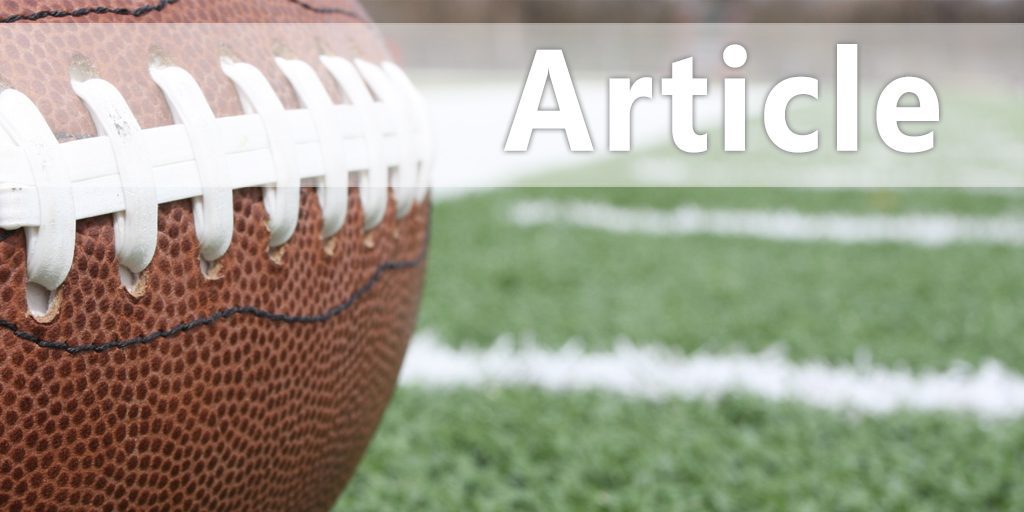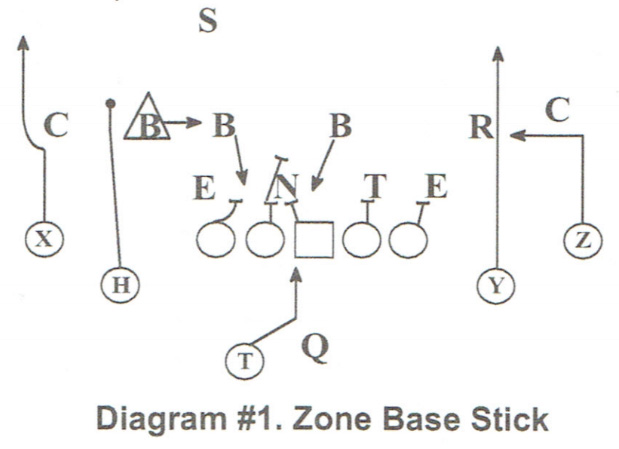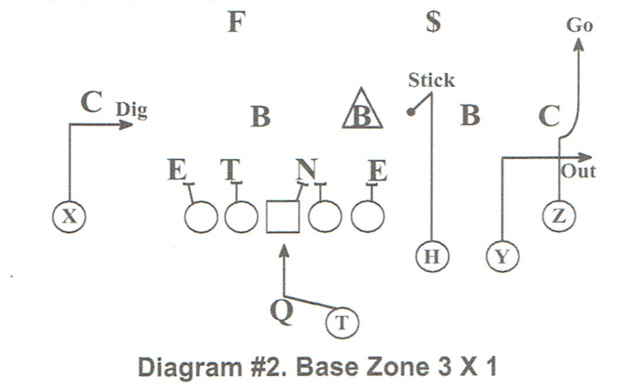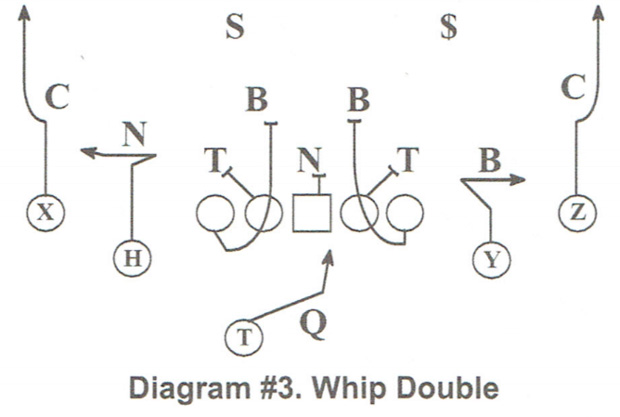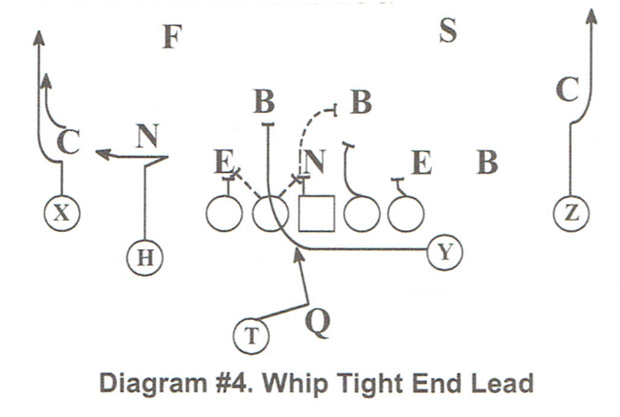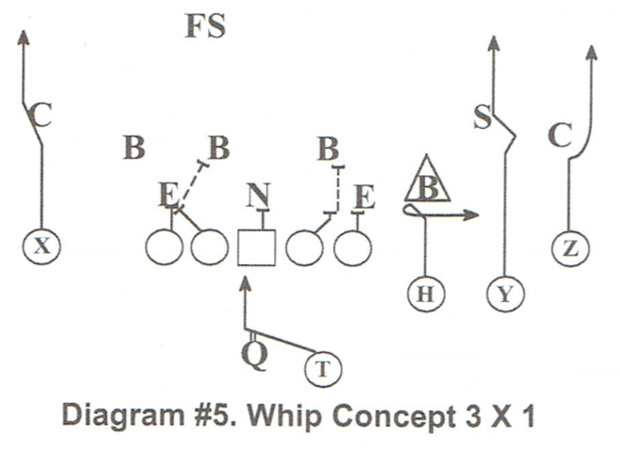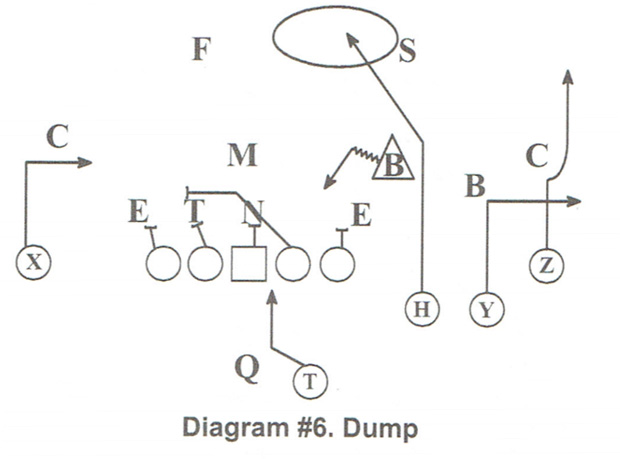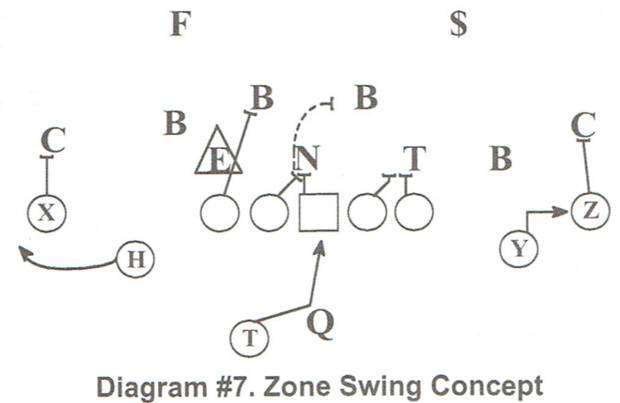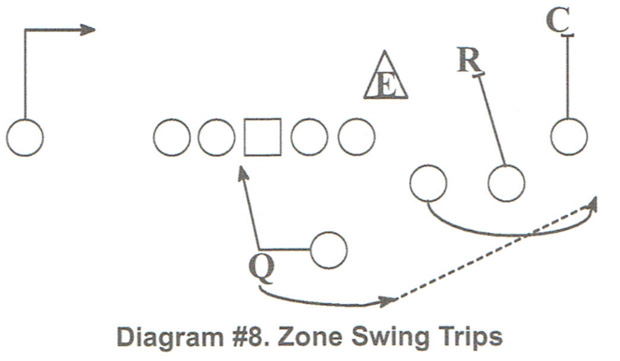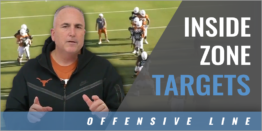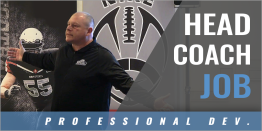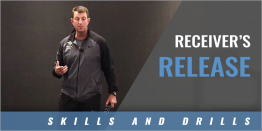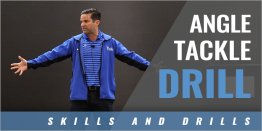| Changing the Mind-Set: Developing RPOs |
| By: Daniel Oelschlagel - Richland HS, TX
Originally Published in: Nike 2017 Coach of the Year Clinics - Earl Browning Provided by: Nike Coach of the Year Rebel by the Numbers • 47 - We scored 47 points a game • 2 - Most improved offense in the state of Texas, number one in 5A football • 565 points scored breaking the school record by over 200 points • 42 touchdown passes the second previous high was 26 • 1984-2016 - We won our first playoff game in 32 years We played with some freaky talent this year. We played a different style of offense. We broke the school record for touchdown passes in the seventh game of the season. We won our first playoff game in 32 years. We went back and looked at what we changed to achieve this success. What did we Change? • Adopted a new mindset • "May God have mercy on my enemies because I will not" • No mercy • Instill it in the player's minds on day one • 7-on-7 state tournament • Daily workouts • Classroom • Make them believe it • Our players thought they were untouchable Adopting the new mindset was a tremendous thing with our players. The previous year we were 3-7, but we were in the 6A division. In that division we were in a lot of the games and played bigger schools and it was a tough schedule. Dropping into the 5A division helped us. The mindset the players had was that they could go out and beat anyone on our schedule. We wanted the players to know that this was a new year and we wanted to instill in them that we were not going to take any mercy on anyone we played. We ended up 10-2 this year and went 6-1 in the conference. We had to make our players believe in what we were doing. If they believe that is half the battle. I wanted to create a mindset that they were better than anyone they played. They believed they were and it showed in the season. We adapted that mindset to include their academic, their weight room work, and their all-around effort. That was what we changed with the players. The coaches was a different story. We had to rethink our goals. Coach Ged Kates, our head coach, always believed that one of the goals was to be the fastest, strongest, and best conditioned team on the field. I went to him after last season and suggested we need to play smarter football. We put that in as one of our goals. What did we Change • Goals: We always talked about being the fastest, strongest, and best conditioned team on the field • We need to be the smartest team on the field • Teach do not tell; If you cannot get the players to understand the concept of why we do things, we will never be stellar at what we do • Go fast - We try to go as fast as humanly capable in certain drills and games. This leads to better RPO's, which leads to better play calling Everyone always says, It is not the X's and O's but it is the Jimmy's and Joe's." I believe that too, but I think the scheme is part of it too. If your players believe in the scheme and understand it, you have a good chance at success. Being the smartest team on the field goes back to the coaching. I always tell the coaches to teach, do not tell. I put that on every handout, power point, and anything that goes to the players. I worked with a coach at another school that was constantly telling them they were making mistakes and he had told them a thousand times what to do. Apparently, that was all he was doing. He was not teaching them, he was telling them how to do it. You have to teach the players what you want them to do. How do we go fast? • Signals: we signal to the offensive line as well as the skilled player. This helped in the logistic of relaying the play. • Limit Vocabulary: the less you signal the faster you can go. • Drill it: BTW (balls to the wall) drill was something we incorporated instead of conditioning. • RPO's: use RPO game to aid with the play calling to where you are never wrong as a play caller. The offense line getting the play by signal was a big step to us going fast. This keeps the quarterback from having to relay the play to everyone. They all get signals and it speed us up. They get to the line of scrimmage, set their feet, and then look to the side line of the signal. The offensive linemen do not have any problems with signals because they are probably the smartest players on the field. The second thing we did was to limit the vocabulary. The RPO's which I am going to show you are all called with one word. Within that one word is the play, protection, direction, and pass scheme. Instead of conditioning we did tempo drills. The BTW drill is that type of drill. We place footballs about seven yards apart. We put them down the field and at different hash marks. The offense runs on the football and gets the play from the sidelines. We snap the ball, run the play, and sprint to the next ball. They get the signal, call the play, run the play, and sprint to the next ball. They do this the entire length of the field. The first thing you do as a team is to develop the signals and tempo. The last thing you do, if you want to go fast, is to use the RPO game. The RPO makes you a better play caller. It keeps you from being wrong, if they execute the play correctly. The first RPO I want to show you comes from a 2 X 2 set. We have the X-receiver and H-back in a wide slot to left with the Y-tight end and Z-receiver in a wide slot to the right. (Diagram #1) The base play in this set is inside zone right. The tailback is sitting left of the quarterback in an offset alignment. The Z-receiver is going to run a mini-dig. That is a three step dig pattern. The job of the Y-tight end is to run the safety out of the play. To the backside, the X-receiver takes an outside release and runs off the deep coverage to his side.
The inside receiver runs a "stick" route between the outside flat coverage and the inside linebacker to that side. That linebacker may be a nickel back. The quarterback has a pre-snap read. He is looking to the mini-dig. If the area is muddy, he goes to his post-snap read off the nickel or outside linebacker to the H-back side. He runs the inside zone play to the tailback and keys the linebacker. If the linebacker attempts to fill toward the line of scrimmage, the quarterback pulls the ball and throws to the H-back on the stick pattern. The Z-receiver has three steps to make the corner think he is going deep. He drives hard for two steps and on the third step, he runs the pattern to the inside. That is the quarterback's pre-snap read. If the quarterback does not like that pattern, he runs the zone play. He is going to leave the ball with the zone runner or throw the stick pattern. The quarterback puts the ball in the tailback's pocket and rides him. If the key attacks to the line, the quarterback pulls the ball and "turns-two." That is the term we use for the quarterback throwing the ball as quickly as he can to the stick pattern. The "turn two" phrase comes from a shortstop in baseball getting the ball out of his glove and throwing to first on a double play. He makes the transition from the read to the throw. He wants to turn the double play. We drill the "turn-two" every day. If we run the play from a tight end formation to the Z-receiver side, we are still running the same patterns. tight end is going to clear out the coverage over the top of the Z-receiver. The Z-receiver still runs the mini-dig and everything else is the same. When we run the play from the 3 X 1 set, not much changes. (Diagram #2) To the trips side, the Z-receiver takes an outside release and gets deep. He wants to take the top off the coverage. The number-2 receiver is the Y-tight end. He runs a speed out at 6-yards. The number-3 receiver runs the stick route. On this play we read the linebacker aligned closest to the number-3 receiver. If he fills on the zone play, we pull the ball and throw the stick pattern
On the single receiver side the X-receiver runs the mini-dig. From this set we do not get this pattern very much. The overhang linebacker to that side always muddies the read to that side. These are five yard patterns that could break for 50-yards. We had those kinds of receivers. Early in the season we played a 3-3 stack team that did all kinds of crazy things. In our game plan, I went away from what we normally do. That was a mistake and we ended up with our second least amount of points in scoring this season. We scored 28 on them where we had put up 50 and 60 against everyone else. Later on during the season we played a team that based out of the 3-4 defense. I told the coaches that we were not going to do what we did the last time playing a three-man front. We were going to do our regular stuff that we had done all year. I wanted to create new RPO's that fit within our scheme. When we scouted this team, we thought they were playing a 2-read concept or maybe even a cover-4 scheme. We decided to run a double whip route at them. From the 2 X 2 set, the outside receivers ran the clear patterns. (Diagram #3) They took outside releases and ran the corners off. The inside receiver ran whip patterns to the outside. The whip pattern is an out cut after a step movement to the inside as if running an "in" pattern. We told the quarterback in his pre-snap read to pick a side he was going to work. We ran the whip routes by the inside receiver to influence the cover-4 coverage. If the number-2 receiver released to the inside, the safety turned to the number-1 receiver and doubles on him.
We wanted to get the safety moved and run the route off the outside linebacker or the apex player covering the slot receiver. The pre-snap read was to take the side the quarterback was most comfortable with. The post-snap read worked off the conflict defender. Someone had to play the zone play. If he played the zone, we threw the whip route to that side. If he played the receiver, we gave the ball to the tailback. The run blocking scheme had to be adjusted. If the defensive end played 5-techniques, we could base block them. However, when they put those defenders in a 4i-technique we had to change the blocking. If the defensive end aligned in an inside shade on the offensive tackles, we used a fold blocking scheme. The offensive guard blocked out on the defensive end and the tackles folded around the out blocks and up on the linebackers. It was more of a draw blocking scheme than zone blocking. Off this play we run a split zone with the Y-tight end coming across the set and blocking the inside linebacker. (Diagram #4) We brought the tight end from a sniffer position across the backfield and up into the B-gap. He isolates on the inside linebacker. We still had the whip concept to the two receiver side and a lead blocker for the tailback. The line blocking does not change. We were lucky to have a center that could handle a nose by himself. He was a squatty-body, but he could block. Also on this play we have gone to a play action game and thrown to the X-receiver running the skinny post. If we find the safety rolling down or playing fast to the whip route, we run the post behind him. This was a call that came down from the booth. It was not part of the read. In the read we either hand the ball or throw the ball to the short pattern.
When we run the whip concept from the 3 X 1 formation, it is the same play. (Diagram #5) The number-1 and 2 receivers run vertical routes to clear the corner and safety out of the play. The apex player aligned on the number-3 receiver is the key for the quarterback. Whatever he does, is wrong. If he supports the run, we throw the whip concept. If he plays the whip, we hand the ball off.
There is no pre-snap read because we have only one side to work with the RPO. We key the defender in conflict and throw the opposite of what he plays. The offensive linemen are either base blocking or folding if the 5-technique defenders tighten their alignments. Later on in the year, we let the single receiver run a mini-dig on this play. He then became an option. Our X-receiver was really good. This is a successful play and become a big play with a short pass. We try to snap the ball as quickly as possible. In a red zone situation, we can run to the ball, get to the line, get the play from the sidelines, and snap the ball in 15 seconds. Most of the time the defense is gassed from the last play. If we think the defense is going to play pass, we can use the draw concept from this set. When we run the draw, the quarterback takes the snap, shows the ball and hands to the tailback. In this case, we will block the defense with a fold blocking scheme. When we read five in the box, we are going to run the football. We had an excellent running back this past year. The whip concept is a good pattern to run against man coverage. The receiver works in one direction and reverses his action and goes outside. Our receivers were very crafty route runners. The reason we do what we do and in my mind is a part of my philosophy, is the idea of getting your best athletes in space. Tackling in space is a challenge for the best defensive backs. That is why we try to constantly put them in that situation. The next pass is called "dump." It is a form of the stick play. (Diagram #6) In the pre-snap read, we are looking at the single receiver. If there is inside help showing we work the base zone concept. If the linebacker is in the box and the defensive back aligns, with no leverage position, we want to work the three receiver side. On the dump play we are looking for the apex linebacker to fill back in the box on the run. We want to send the number-3 receiver into the middle of the field splitting the safeties.
As soon as the quarterback sees the over-hang linebacker commit to the run, he is going to throw the ball into the area that the linebacker vacated. We are not stopping the receiver. He runs his pattern through the linebacker area and into the middle of the field. It is not a slant pattern, but resembles that type of play. The quarterback is throwing the ball right over the apex linebacker's head. The receiver is going to catch the ball on the run and is between the two high safeties. This play has potential for a big play. We can run all of these concepts from a number of formations. With the tight end aligned tight into the trips formation, he is the number-3 receiver and the one that goes down the middle. He arc releases and runs up the seam behind the linebacker. The quarterback reads the Mike linebacker. If he steps to fill the zone play, the quarterback throws the ball over his head to the tight end. We can align in a 2 X 2 formation, bring the slot back in motion to the other side and use him as the number-3 receiver in the same area. There are a number of ways we can get into that play. We run a zone swing concept. (Diagram #7) If a team starts stopping what we do, this is one of our answers. The quarterback is going to run the true zone play and read the defensive end. We have a swing side to the backside of the formation, he is on the crawfish side to the wide side of the field.
If the crawfish concept is to the single receiver side, the receiver runs a three step hitch. If there two or three receivers in the formation, the pattern is a one step. show your number to the quarterback, and wait for the ball. If the conflict defender is within seven yards of the receivers, the play is off. If he is not within seven yards we want to throw the ball immediately. To the backside, the quarterback is reading the backside end. If the defensive end closes to the inside, the quarterback pulls the ball and gets out on the edge. The X-receiver release down field and blocks the corner. Since the ball is thrown behind the line we can block in the secondary. The quarterback rides the tailback, pulls the ball, and hits the swing back with a ball behind the line of scrimmage. When we run this play from the trips set, it looks like a bubble screen. (Diagram #8) The quarterback reads the defensive end. If he gets the pull key, he pulls the ball and hits the swing pattern into the trips side of the formation. The number-1 and 2 receivers are blocking in the secondary. The number-1 receiver blocks the corner and the number-2 receiver cracks on the first defender inside of him. The number-3 receiver runs the swing. To the backside, we can run the mini-dig.
We threw 42 touchdowns this year and had only two sacks. One of the sacks was in the first game of the season. It was a sack-fumble. The other fumble occurred in the last game of the season. With this play, if the swing is not there, the quarterback can turn up the field and run the ball. We did not want our quarterback to run too much because he was such an aggressive runner. He tried to make too many plays with his legs. All this offense goes back to the idea of whether the players understand the concept. If they understand it we can go fast and they can play fast. I believe this offense could run itself. I would like to think I am the best play caller in the world. However, the players understand the offense, make the right decisions, and the plays are successful. It is their execution that makes the offense go. We taught it to them from day one. They know what we expect them to do. They understand the scheme of what we are trying to do. If you want any of these things contact me. I love to talk football. I have all kinds of drills for the quarterback. I have drills for the "turn two" movement. It involves the arm angles and hard throws. I have drills on rapid fire throwing drills. The "balls to the wall" drill is a great drill. In that drill we ran 40 plus plays in 8 minutes. They are conditioning without knowing they are conditioning, which is the good part about it. Anything else. I hope you can feel free to come talk to me. If you need anything come see us. |
